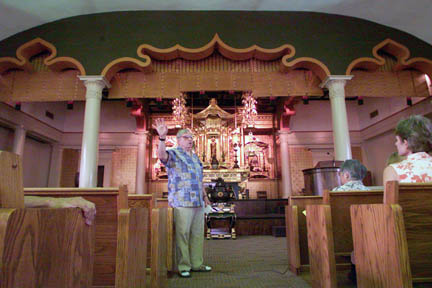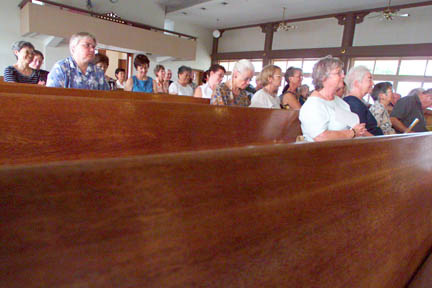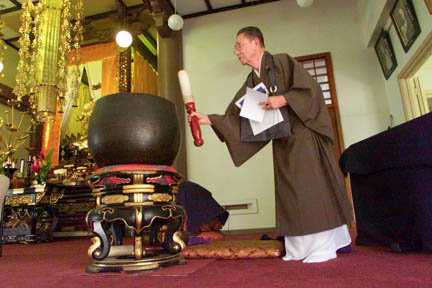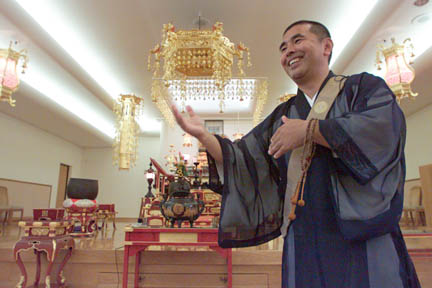

|
View from the Pew Mary Adamski |
Temple tourists
Tours of three isle Buddhist temples
help share the essence of the religion
with other faiths
Enter a church as a stranger and it's normal to become bewildered, if not scared off, by what's strange to you. Music, rituals, devotional objects -- is it OK to just watch? Is this committing a faux pas or committing to something beyond my belief?
Buddhist servicesMost Hawaii Buddhist temples hold Sunday services, a practice that reflects the American workweek rather than Buddhist custom. Services are open to visitors:» Honpa Hongwanji Betsuin Hawaii, 1721 Pali Highway, 10 a.m. Sundays, English service. » Soto Mission of Hawaii, 1708 Nuuanu Ave., 9 a.m. Sundays, English sermon. » Nichiren Mission, 33 Pulelehua Way, 10 a.m. open meditation, fourth Sunday of month.
|
"It is not an idol, but an image," said the guide in describing the statue of Buddha in an ornate gilded altar at Honpa Hongwanji Temple, the large white landmark near the beginning of Pali Highway. "Some religions thought that an image had power. We don't think that at all," said retired University of Hawaii professor Al Bloom, a Buddhist minister. Not a space for worship, the altar is meant to display a setting in which Buddha teaches his followers.
"The essence of Zen discipline is to lead a life with minimum possessions and maximum contentment," Bishop Jiho Machida told the tourists at Soto Mission of Hawaii, with its picturesque Indian stupa tower amid the mundane apartment architecture on Nuuanu Avenue. The founder of the sect taught that "meditation is not for gaining anything, it is for concentration, to realize ourself," Machida said.
"I ask people, do you make your bed every day?" the bishop told the tourists. "It is not difficult to do, but it is difficult to continue. That's life.
"The basic teaching is not very difficult to understand, but it is difficult to continue to practice," Machida said.
The practice of sitting and chanting a simple phrase over and over "connects the body, the mind and the mouth," said the Rev. Chishin Hirai, of Nichiren Mission, its roof a white sail amid tall trees near Oahu Country Club. "My feelings come up, problems are on my mind, but when I keep myself quiet and calm down, I feel peaceful. I can concentrate on myself."
Hirai said people new at meditation want a primer. "They worry about details. I tell them, just do it and you will get used to doing it."

|
Nichiren followers recite a polysyllabic chant that translates to "I devote myself to the Lotus Sutra," referring to the sect's key scriptures, one of hundreds of texts and sermons attributed to Buddha and his disciples.
"I take refuge in the infinite" is the translation of the chant used at Honpa Hongwanji.
In Hawaii, Buddhism is perceived as a Japanese religion because it was brought here by the first immigrants from Japan. But the Hongwanji and Soto buildings are of Indian design, reflecting its origin in India. In about 500 B.C., Prince Siddhartha Gautama, seeking to understand the suffering he saw, achieved the state of perfect awareness and understanding of the impermanence of worldly life. Others who achieved that state of enlightenment are also called Buddhas. His teachings, interpreted and expanded by disciples through the centuries, are followed by Buddhists who are aligned into a wide variety of sects and denominations, much like Christianity.
Buddhism was introduced to Japan in 550 A.D., Bloom said. Hongwanji, Soto, Nichiren and other sects here were founded by teachers in the Kamakura Period, 1186-1330. "It was a period when spiritual activity was heightened because of revolution and societal change," Bloom said.
"Temples in Hawaii became Japanese enclaves," Bloom said, and the focus of cultural life for the immigrant generation.

|
A question to Machida was about the practice of remembering a dead family member on set anniversaries -- the seventh day, the 49th day, the first year.
"That is a Japanese custom. It has nothing to do with Buddhism," the bishop said.
The information came as a surprise to several of the temple tourists, second- and third-generation Japanese Americans.
"That really surprised me. We did lots of things we thought were Buddhist, but they were Japanese," said Toshiko Kido, one of several visitors from Keolumanu United Methodist Church.
The expedition into temples was sponsored by the United Methodist Women at the Kailua church, as the finale of a three-part series, "Creating Interfaith Community," which drew about 80 people each night to hear Hindu, native Hawaiian, Bahai and Buddhist speakers.
"Our community life is shared by believers of more than one religion inspired by their faith," said Jane Larson, coordinator of the Keolumanu program.
"We are studying the possibility of reaching out and seeking ways we can work toward the betterment of all."
Larson said: "Some religions have walls drawn up. We are not letting go of our own core beliefs when we reach out and understand others better so we can work together for our community.
"It gives us a broader understanding of what our society is all about and a perspective on who makes up God's people."

|
The local women are part of the 1 million-member Women's Division of the national United Methodist Church. Each year, United Methodist Women across the country pursue three mission studies. The first is a project on spiritual life, and the second is a regional study about social issues and projects in a particular place. This year, under the third category of general knowledge, they looked for ways to create interfaith community.
The Kailua women invited others along for the exploration.
Jane Rowland, of Honolulu, said she had concluded even before the temple tour that "all religions have truth, wisdom, sources of inspiration."
Bob Schoch said he is taking a college course on Japanese religions. "It is neat to reflect on my own Christian experience through other perspectives."
Bill and Trudie Regan, who moved to Oahu from Pennsylvania this year, said an interest in the art of the mandala, an intricate circular pattern of Buddhas and sacred figures, led them to begin studying Buddhism.
"I find comfort in this teaching," said Bill Regan, who was raised a Catholic.
Sonan Bumden, who teaches Tibetan Buddhist meditation at the Shambhala Center in Kailua, said he is recently arrived from Bhutan, and "I am interested in all the sacred places here."
Randy Francis and Jessie Mitchell, members of the First Unitarian Church, said their congregation joins the Nuuanu Buddhist temples in an annual Thanksgiving service. "This seemed like a good chance to know more about the neighbors," Francis said.
Buddhist Bloom said: "Our members don't know much about other religions. Buddhists don't go anywhere, either, except when there is a funeral or family event.
"We talk about pluralism, but we don't know much about others."

|
Email her at madamski@starbulletin.com.